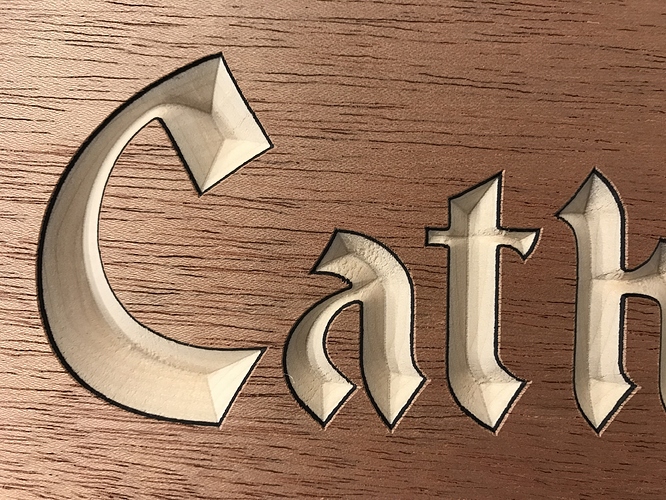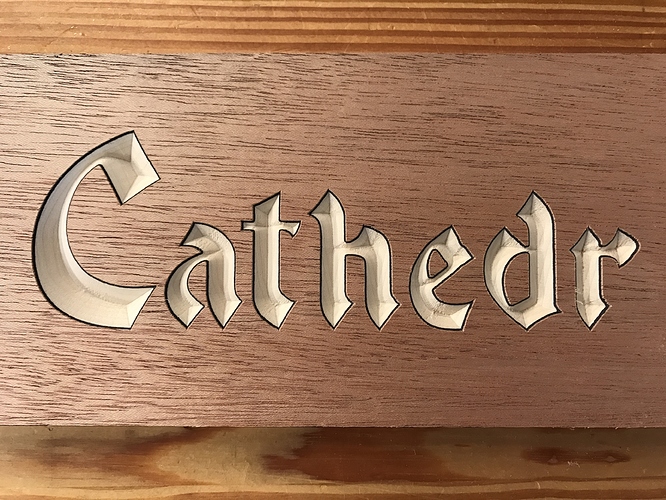Hi All,
I’m trying to perfect a logo I’m working on for a project and I think I’m about there. I’m really happy with the effect I get with the two layers of veneer on top of the white maple but I can’t figure out how to eliminate the tear out in the maple that you can see in some areas. (I know maple tears out easily anyway) I’m using a brand new 1", 2 flute V bit at 30 in/min, plunge of 15 in/min.(A previous experiment burned a little when I went slower at 15 in/min.) and the Dewalt 611 set a the lowest speed setting. I also tried doing a second pass with the Z set 1 or 2 thousands lower than the first to act like a final pass without much change. I used VCarve Pro for the toolpaths and I don’t see a way to do final pass or climb cut with the V carving toolpath.
Any help you guys might be able to provide would be appreciated!
Some things to try:
- cover the wood w/ blue painter’s tape, then remove that carefully after cutting
- finish the wood before cutting — cyanoacrylate or lacquer in particular seem to harden the wood fibers and secure them together
- try a finishing pass — zero as much higher by your desired roughing clearance, then re-zero for a second pass w/ depth of cut set to stock thickness (so as to make a single pass)
- use a piece of wood w/ an interlocking grain structure — curly maple might work better here (but will be pricey)
JF, that’s a nice effect with the two layers of veneer. The maple provides a nice contrast. Very nice work. You will notice a difference between hard vs soft maple. Its is just a characteristic of the species. Sometimes a piece will cut like butter and next piece will ripple or even fuzz up. Maybe someone on the Vectric forums will have more insight.
I was trying to think of a better substrate that will still produce your effect. If you live near a good hardwood lumberyard, you will notice quite a bit of cherry is very light colored, though it will age a bit darker over time. Cherry v carves well.
I would try a faster feed rate 50 + then do another pass at your 30 with no other changes i.e z depth. I have done a lot of v carving with v carve pro (none in maple though) and always run 50 - 70 ipm and dewalt at a 5. good luck
Fiero, you are so right. I was so impressed by the contrasting effect I didn’t read his cutting parameters. Your recommendations are spot on.
I just tried a bunch of v carving speeds and feeds in some maple. Every time it cut with the grain I would get tear out or fibers, regardless of my speeds and feeds. Nature of the beast (maple) ?
Thanks so much. I’ll totally confess that the black veneer was the idea of a more creative friend when we were discussing this project but I love it. Now I’m thinking of all the other applications I could use it on, different thicknesses for line weight, different colors, etc.
For this project I’m locked in to using maple since other parts of it are already done and utilize mahogany and maple. I’ve definitely had my battles with maple and tear out in the past. I know how to take care of it with a hand plane and/or a card scraper but I’m new to CNC, so I appreciate the help.
Thanks for tipping me off to Cherry. That would look amazing with the black veneer outline and maple or some other light wood up front!
I’ll definitely give that a shot on the next test. Thanks so much for the details!
Also, for the finishing pass, try a brand new, sharp, HSS endmill.
That looks great! Tung oil is a great finish.
Not all V bits are created equal. I have two of them…
i found the one on the left does not cut as near as nice as the one on the right.
I have no input other than possibly misting with water before your final pass. I know they do this when jointing/planning and it can help with challenging grain.
I’ll give that a shot, thank you!

